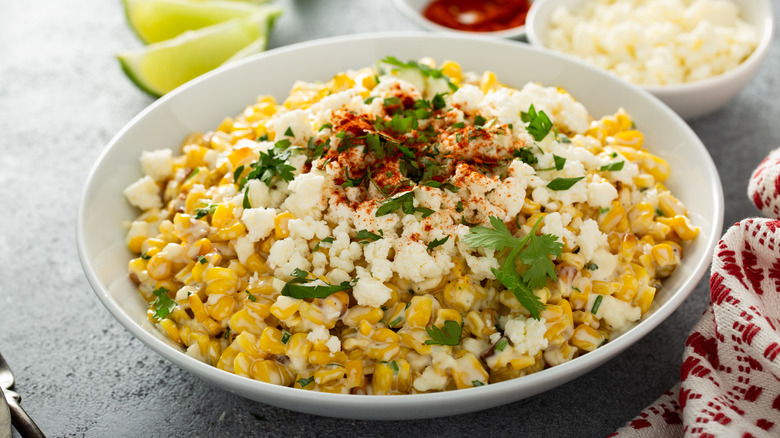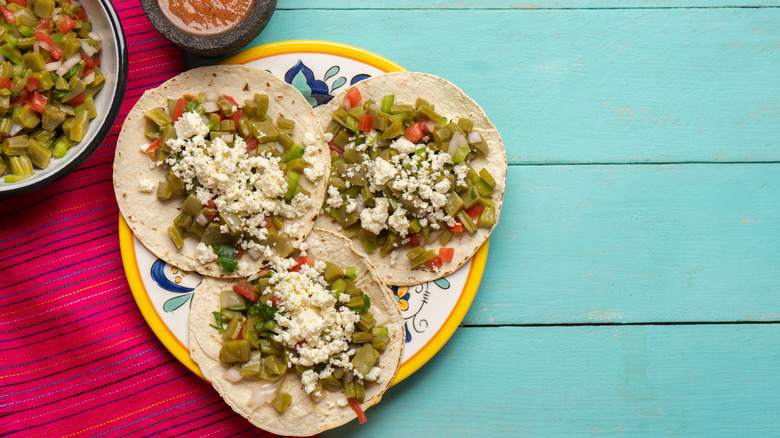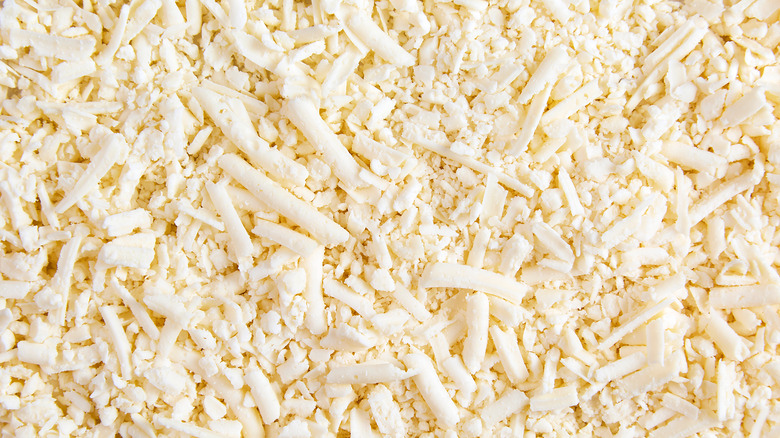Are Cotija And Queso Fresco Interchangeable Cheeses?
In the wide world of dairy, melted cheese gets all the hype. Open any food Instagram and you'll eventually scroll to photos of pull-apart grilled cheese sandwiches or potatoes blanketed by gooey raclette. Pools of fondue entice skewers of meats, bread, and vegetables, while warm mozzarella perfectly puddles over brick-oven pizza. According to The Cheese Professor, these trendy iterations of melted cheese are only the beginning; the cheese haven of south-central France hosts a slew of other cheeses, each ready for the oven, stovetop, grill, or, if all else fails, microwave.
Yes, it's safe to assume that melted cheese encapsulates the glamorous side of the beloved dairy product, yet crumbly cheeses warrant equal attention. Cotija and queso fresco, which crumble far better than they melt (via MasterClass), add flavor and texture to any dish. Specifically, these cheeses work well in Mexican cuisine and to understand their full potential, think beyond classic Tex-Mex.
What is cotija cheese?
Cotija is a specialty cheese named for its origins in Cotija, Mexico (via MasterClass). The soft, white cheese may look delicate — and crumble easily — but its flavor is far more durable than its texture. Cotija is known for its mild and salty taste, as well as its dry consistency. It's been equated with Parmesan, thanks to the salt, fat, and flavor it offers Mexican cuisine.
It's a slightly hard, slightly aged cheese resistant to melting and according to Wisconsin Cheese, cotija enhances the zest of any dish. Practically made for sprinkling, cotija works best as a topping, though the underlying food is entirely up to you. Cotija has the ability to turn any side dish into a central course, and tacos are just the start of the cheese's potential. Mexican street corn with cotija strays from standard barbecue fare, transforming basic corn on the cob into something exciting. According to MasterClass, cotija is also a worthwhile add-on to beans and salads, but can the same be said about its cheesy friend queso fresco?
What is queso fresco?
Similar to cotija in appearance, queso fresco is equally — if not more — common in Mexican dishes. According to Food52, queso fresco translates to "fresh cheese" and is made from raw cow milk or a combination of goat and cow milk. Per Wisconsin Cheese, queso fresco originated in Mexico in the early 1800s. The no-frills farmer's cheese has since become ubiquitous in Mexican culture.
With a mild, milky flavor, the crumbly cheese acts as an easy topping and go-to filling for all kinds of foods. As a mild cheese, queso fresco works particularly well with spicier dishes, cutting the heat with its mild, sour flavor. Food52 recommends using queso fresco in salads, atop soups, and, yet again, over grilled corn. For an elevated snack, try adding queso fresco, as well as tomatillos, to your next batch of guacamole. All it takes is a crumble of cheese to completely alter a dish.
Differences in texture and flavor
Queso fresco and cotija serve similar functions. However, differences in taste, timing, and texture place the two cheeses in their own playing fields. As for timing, cotija is an aged cheese, whereas queso fresco doesn't require any aging time (via Food52), and you will be able to taste the difference. The Kitchn compares queso fresco to goat cheese, feta, and ricotta — versatile and mild cheeses that enhance but don't overpower recipes. As a lighter cheese, queso fresco retains an even and sour taste. It's a cheese that acts as a complement rather than a centerpiece.
Cotija, however, is far more dominant than queso fresco. According to Food52, cotija's salty overtones and firm consistency deviate from queso fresco's soft, mild characteristics. Unlike queso fresco, which can be used in abundance, cotija is best utilized in smaller quantities. All you need is a sprinkle of cheese to upgrade your next taco Tuesday.
Replace queso fresco with cotija on milder dishes
Both queso fresco and cotija enhance any dish with a crumbly, cheesy twist. Yet while the two cheeses serve similar purposes, they add varying degrees of flavor. To help you decide which cheese to purchase for your next enchilada expenditure, the Mexican Food Journal returns to the saltiness of cotija. Given the cheese's powerful taste, you should use cotija sparingly and in dishes that require such a flavor boost. These dishes may include tacos, enchiladas, and eggs ... but, remember, a little cotija goes a long way.
Meanwhile, queso fresco acts as a blank slate and can therefore be used less sparingly. Praised for leveling out spicy foods, the soft cheese is an easy addition within — and beyond — the canon of Mexican cuisine. A sprinkle of queso fresco improves everything from beans to small plates to huevos rancheros (per MasterClass). Just steer clear of foods like quesadillas, which call for melted cheese. Clearly, queso fresco and cotija can be way more than just a garnish.




